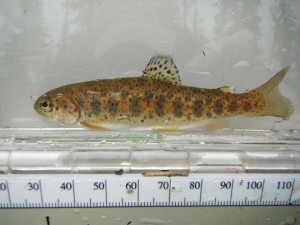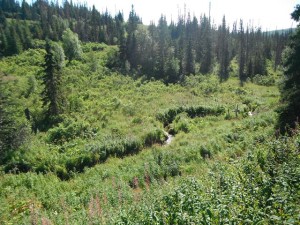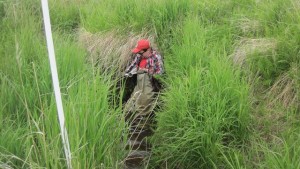by Joe Dawson

Dennis Whigham samples horsetail plants in an Alaskan headwater stream. Credit: Ryan King/Baylor University
In Alaska, fish mean serious money. For fishermen, landowners, and the government, learning all they can about the lives of salmon could pay off in future fish harvests. There’s a lot to learn, down to how a single type of tree impacts their habitat.
The story of those habitats and trees, the alders, has been explored by SERC senior scientist Dennis Whigham and colleagues in a new study published May in Science of the Total Environment. The researchers have been studying interactions between watersheds and headwater streams for almost two decades.
Alders are most recognizable for their egg-shaped, serrated leaves. Their bark is used for tanning leather, and their wood to smoke salmon and make Fender guitars. But alders also have an outsized effect on their natural environment, transforming the chemistry and structure of wetlands and streams nearby. Bacteria in alder roots make nitrogen, an important plant nutrient, available in places where it is otherwise scarce. This can send ripple effects through entire ecosystems. In another plot twist, scientists also expect alder trees to expand northward, stirred by warmer temperatures and higher carbon dioxide from climate change. Whigham’s findings highlight the interconnectedness of wetland ecosystems, waterways, and the valuable fish that call Alaska home.

A Dolly Varden char that was caught by researchers. The fish are held in the water until they can be taken out and measured. Credit: Dennis Whigham/SERC
“There is this strong connection between land and stream and between the fish and the stream,” Whigham said.
The streams Whigham studied flow through Alaska’s Kenai Peninsula, bounded by the Gulf of Alaska and Cook Inlet. To find out how alders fit into their ecosystems, the team sampled two streams in the peninsula whose banks were lined by wetlands. These streams were headwaters, the smallest streams on watersheds that converge to form larger streams and rivers. These types of streams provide critical sanctuary for juvenile salmonids, the group of fish that includes salmon, trout, and char. In the Kenai Peninsula, the headwater streams the researchers have been studying shelter at least 250,000 young salmonids. The only major difference between the two habitats: One stream was in a watershed with alders and the other was not. Whigham studied these wetlands in the summers and falls of 2012, 2013, and 2014.
“While these two wetlands look the same, have nearly the same species of plants and same stream hydrology; fundamentally they are different,” he said.

View of an Alaskan headwater stream similar to the ones studied in Whigham’s latest experiment. Credit: Dennis Whigham/SERC
So, imagine two egg salad sandwiches. Both have boiled eggs, mayonnaise, onions, mustard, salt, and pepper. Both are served on white bread. They’re even in identical plastic baggies, but there is one difference between them: one has cilantro. Are these sandwiches the same? Not by a long shot.
Like the taste of herby egg salad, the structure and chemistry of those Alaskan wetlands differed significantly. Generally speaking, plants have to work for their nitrogen, a nutrient they need for growing and building proteins. Their roots spread wide and grow deep to absorb as much as they can. In really poor soil, plants like the Venus Fly Trap must resort to carnivory to get enough of the nutrient. But alder-loving bacteria have the rare ability to take unusable nitrogen from the atmosphere and deposit it in roots, where it is incorporated into other parts of the alders. Eventually, some of the nitrogen makes its way to the wetlands and into the streams themselves.
“If you give a plant nitrogen, it hardly needs roots,” said Whigham.
And that turned out to be one striking result from the study: Grasses in the ‘Alder’ site had only one fifth as much root mass as in the “No Alder” site, but their roots had three times higher nitrogen concentrations.

Wes Hauser (Wabash College/SERC) uses a soil core to collect soil samples that were used to determine root biomass and the chemistry of groundwater. Credit: Dennis Whigham/SERC
Whigham and his collaborators also found high concentrations of nitrogen in dead plant litter, root biomass, and water taken from wetland soil at the “Alder” site. Previous studies from these researchers found a positive link between the amount of alder on the watershed and the nitrogen concentrations in streams. All this information is helping develop tools that could support better land and water management, says Whigham.
“If we know enough, we can give the landowners information about the land and the watershed around them and allow them to make good decisions.”
While the exact effects on these streams and juvenile fish are still unknown, other research suggests that because nitrogen-spiked plants have more green mass aboveground, additional nitrogen could lead to more plant-eating organisms, rippling up the food web. But two other effects of the alder-bacteria interaction that the scientists found—decreases in belowground biomass and increases in decomposition—will likely lead to lower levels of soil carbon, changing balances in the carbon cycle plants and animals depend on. Furthermore, less root mass could mean less-stable stream banks and more sediment in the water. Figuring out the risks and outcomes of these changes could lead to healthier fish populations.
Or, as it’s known in Alaska, big money.
C.M. Walker, J. Maurer, and S. Baird of Kachemak Bay National Estuarine Research Reserve, University of Alaska; R.S. King of Baylor University; W. Hauser of Wabash College; J.A. Keuskamp of the Netherlands Institute of Ecology; and P.J. Neale of SERC contributed to this research.
Citation:
D.F. Whigham, C.M. Walker, J. Maurer, R.S. King, W. Hauser, S. Baird, J.A. Keuskamp, P.J. Neale, Watershed influences on the structure and function of riparian wetlands associated with headwater streams – Kenai Peninsula, Alaska, Science of The Total Environment, Volumes 599–600, 1 December 2017, Pages 124-134, ISSN 0048-9697, https://doi.org/10.1016/j.scitotenv.2017.03.290.

